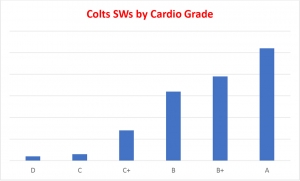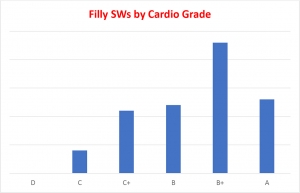It’s not exactly an axiom but it seems almost as soon as a stallion is exported from this country, the racehorses he left behind start making a lot of noise. Without getting too deep into the bushes by matching these stallions with their offspring–while acknowledging Empire Maker, Hard Spun and Daredevil among the previous and recent returnees–we present such examples as New Year’s Day (Maximum Security), Declaration of War (Decorated Invader) and Eskendereya (Mitole).
To this list we have added Super Saver, one of the more surprising exports of the past few years, a stallion who is back in the news after a couple of years at his new home in Turkey (where Daredevil was originally exported). We are not going to engage in any finger-wagging over his exportation, however, even considering the fact that in his absence his son, Eclipse winner Runhappy, has turned out to be the most promoted young stallion in the history of the game. Another son, Competitive Edge, has had a spiffy start at stud, and yet another, the 3-year-old Happy Saver, achieved undefeated Grade I-winning status while pummeling his older opponents in the Jockey Club Gold Cup last month.
Rather, we are going to look at Super Saver within the context of how he has emerged as the savior of an exceptionally iconoclastic sire line by examining the evolution of his tail-male ancestors in biomechanical terms–data which prompted eyebrow-arching when we completed our research.
On pedigree alone, Kentucky Derby winner Super Saver is a good story. His genes are infused with history and classicism which should not be a surprise since he traces in tail-female to the epochal *La Troienne through the branch established by Numbered Account, his fourth dam.
But the irony of this horse’s impact on the breed thus far stems mostly from the almost happenstance survival of his five-generation sire line tracing back to the line-founding Raise a Native through that one’s sometimes “misremembered” son, Kentucky Derby and Preakness winner Majestic Prince.
Majestic Prince, a foal of 1966, was a big, strong-bodied chestnut resembling his sire in many visible ways. Although we do not have his biomechanical measurements, we have his daddy’s, and those of his four sons who made some impression at stud: Coastal, Eternal Prince, Simply Majestic and Majestic Light. Based on their critical measurements, most of Majestic Prince’s sons had mixed biomechanics which led to their modest records as sires of sires.
Except, of course, for Majestic Light.
Although he may have appeared to the naked eye to be a bit light, except for his bay color, Majestic Light was, indeed, a close physical replica of Raise a Native (and by implication Majestic Prince). He had the same height, heart girth and almost identical measurements through the ilium, femur and tibia–the power and acceleration compendium through the hip and hock–as Raise a Native.
However, he differed substantially in the length of his rear cannon, which turned out to be quite a bit longer than his grandsire’s, and one not common in the stallion population at the time. The rear cannon provides the leverage through the upper leg and hip for enhanced thrust, or power. Indeed, more than one biomechanics analyst commented at the time that the long rear cannons of Majestic Light and his son Wavering Monarch were reminiscent of Dr. Fager, whose overall composition may have left him a bit of an outlier among the population during his lifetime, and therefore may have impacted his fortunes.
Hold that thought.
When we compared the measurements of the tail-male descendants of Wavering Monarch that have long been identified as mostly inheritable in both Thoroughbreds and the overall animal species, we found that the long rear cannon was virtually identical in Majestic Light, Maria’s Mon and Super Saver, but the others were closer to that of Raise a Native.
What spurred our research further was when we started to compare the entire Super Saver tail-male line to how the North American stallion gene pool has evolved physically since the 1970s. To do this we employed a computerized model that points out how a particular stallion resembles other stallions in overall “size and scope.” The program identifies clusters of neighbors, so to speak, much in the way thousands of small towns in Europe, for example, developed as remnants of medieval society. In almost all cases generations of neighbors intermarried and came to be similar to each other in appearance if not also group-think.
What this program gives us is a snapshot into which cluster a stallion “fits”–i.e., is he likely to be consistent in siring quality given the proven sires in that cluster similar to him physically. We chose four eras in which to examine this data.
- Group 1: 850 stallions who were born from in the second half of the 20th Century and who went to stud prior to 2000;
- Group 2: Group 1 plus those who went to stud in the years between 2000 and 2015;
- Group 3: Group 2 plus those who retired between 2016 and 2020, minus abject failures;
- Leading Sires: Group 3 edited to 250 stallions who had achieved major status since the 1960s.
The results are quite interesting. For example, Raise a Native consistently came up in each group as most similar to Roberto and Affirmed, which indicates that these three would have been successful at stud no matter when they went to stud. As it turned out, Majestic Light has Roberto, Affirmed and Red Ransom in his clusters along with his son Wavering Monarch. The latter numbered his sire as a neighbor but only among the smaller group of leading sires; among the other groups he was closer to Quiet American and his sire Fappiano–two substantial individuals with genetic connections to the aforementioned Dr. Fager.
The line took a completely different turn through Maria’s Mon who most often comes closest to Lemon Drop Kid, Forestry and Broad Brush, while his son Monarchos is almost a throwback numbering Roberto, Red Ransom, Affirmed and Majestic Light in his clusters. As for Super Saver’s sons Runhappy and Competitive Edge, we can only point to Afleet as showing more than once in their clusters.
Super Saver? Remember we told you to hold that thought about Dr. Fager? That’s because we ran him through the same program and found that starting with the Group 2 stallions, he and Super Saver came up as close to Scat Daddy, Empire Maker and Kitten’s Joy. This gives us a hint if Super Saver is repatriated that mares by those stallions might make useful mates. But it also gives us an indication that Dr. Fager may have “fit in” better in the 21st Century than he did in the 20th.
In this case, it certainly appears to make a difference how they carry on.
Bob Fierro is a partner with Jay Kilgore and Frank Mitchell in DataTrack International, biomechanical consultants and developers of BreezeFigs. He can be reached at bbfq@earthlink.net.
The post Body & Soul: Please Do Talk About Me When I’m Gone appeared first on TDN | Thoroughbred Daily News | Horse Racing News, Results and Video | Thoroughbred Breeding and Auctions.
 system and published daily since 2005 by Daily Racing Form online (
system and published daily since 2005 by Daily Racing Form online (

